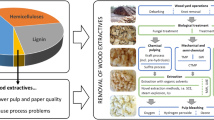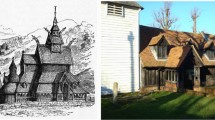Abstract
This study presents a comparative evaluation of semi-destructive and destructive testing of wood. Semi-destructive methods are represented by screw-withdrawal test, microdrilling, pin penetration and a new construction of a diagnostic device for in situ evaluation of timber based on the principle of measuring the mechanical resistance to pin being pushed gradually into wood. In order to ascertain the differences between the methods, measuring of three basic softwood species was conducted. One of the aims was to capture the variability of properties brought about by the distribution of properties along the diameter and along the trunk (section) length; therefore, an entire trunk of spruce, fir and pine were used for testing. The accuracy of the prediction of mechanical properties provided by the semi-destructive devices was verified using correlations with mechanical properties established by standard pressure tests in compliance with European norms. The results show a very good correlation of the mean force necessary to push the pin in the timber with wood density and strength in compression along the grain found in standard specimens.

















Similar content being viewed by others
References
Cai Z, Hunt MO, Ross RJ, Soltis LA (2002) Screw withdrawal—a means to evaluate densities of in-situ wood members. In: 13th International symposium on nondestructive testing of wood, Richmond, pp 277–281
Divos F, Kiss FS, Takats P (2011) Evaluation of historical wooden structures using. In: SHATIS’ international conference on structural health assessment of timber structures, Lisbon
Drdácký M, Jirovský I, Slížková Z (2005) On the structural health and technological survey of historic timber structures. In: Proceedings of the international conference: the conservation of historic wooden structures, vol I, Florence, pp 278–284
Drdácký M, Kloiber M, Kotlínová M (2006) Low invasive diagnostics of historic timber. In: In-situ evaluation & non-destructive testing of historic wood and masonry structures, RILEM workshop, Prague, pp 24–40
Emerson R, Pollock D, Kainz J, Fridley K, McLean D, Ross R (1998) Non-destructive evaluation techniques for timber bridges. In: Proceedings of the 5th World conference on timber engineering, vol I, Montreux, pp 670–677
Görlacher R (1987) Non-destructive testing of wood: an in situ method for determination of density. Holz as Roh-und Werkstoff 45:273–278
Gryc V, Holan J (2004) Influence of position within the tree stem according to growth-ring of spruce (Picea abies/L./Karst.) with compression wood. Acta Univ Agric Silvic Mendel Brun 4:59–72
Kasal B, Drdácký M, Jirovsky I (2003) Semi-destructive methods for evaluation of timber structures. Structural studies, repairs and maintenance of heritage architecture VIII. In: Brebia CA (ed) Advances in architecture. WIT Press, Southampton, pp 835–842
Kasal B, Tannert T (2011) In situ assessment of structural timber. State of the Art reports. Springer, ISBN 978-94-007-0559-3
Kloiber M, Kotlínová M, Tippner J (2009) Estimation of wood properties using pin pushing in method with various shapes of the penetration pin. Acta Univ Agric Silvic Mendel Brun 2:53–60
Kloiber M, Tippner J, Drdácký M (2011) Semi-destructive tool for “In-situ” measurement of mechanical resistance of wood. In: SHATIS’ international conference on structural health assessment of timber structures, Lisbon
Kloiber M, Tippner J, Hrivnák J, Praus L (2012) Experimental verification of a new tool for wood mechanical resistance measurement. Wood Res 57(3):383–398
Machado JS, Cruz H (1997) Evaluation of the conservation of wooden structures. Determination of the density profile for non-destructive methods. Portugal J Struct Eng 42:15–18
Marčok M, Reinprecht L (1997) Detection of wood decay with ultrasonic method. Wood Res 42(1):11–22
Pellerin RF, Ross RJ (2002) Nondestructive evaluation of wood. Forest Service, Forest Products Laboratory, Madison
Rinn F, Schweingruber F, Schär E (1996) Resistograph® and X-ray density charts of wood comparative evaluation of drill resistance profiles and X-ray density charts of different wood species. Holzforschung 50(4):303–311
Rinn F (1994) Catalogue of relative density profiles of trees, poles and timber derived from Resistograph® microdrillings. In: 9th International symposium on non-destructive testing, Madison, pp 61–67
Tippner J, Kloiber M, Hrivnák J (2011) Derivation of mechanical properties by pushing of a pin into wood. In: 17th International nondestructive testing and evaluation of wood symposium, Sopron, pp 575–582
Acknowledgments
This paper was created with a financial support from grant project DF11P01OVV001 “Diagnostics of damage and life span of Cultural Heritage buildings”, NAKI program, provided by the Ministry of Culture and institutional support RVO 68378297.
Author information
Authors and Affiliations
Corresponding author
Rights and permissions
About this article
Cite this article
Kloiber, M., Tippner, J. & Hrivnák, J. Mechanical properties of wood examined by semi-destructive devices. Mater Struct 47, 199–212 (2014). https://doi.org/10.1617/s11527-013-0055-z
Received:
Accepted:
Published:
Issue Date:
DOI: https://doi.org/10.1617/s11527-013-0055-z




